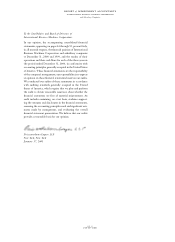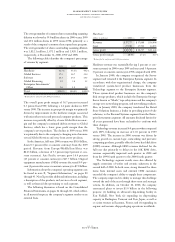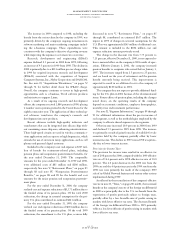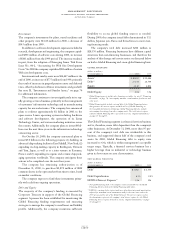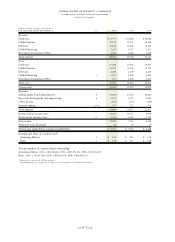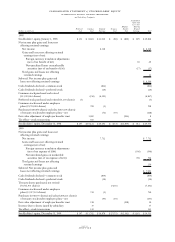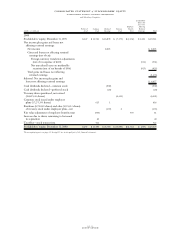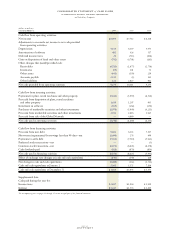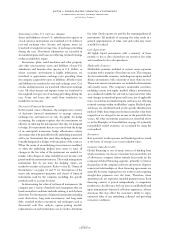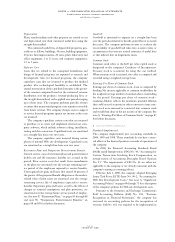IBM 2000 Annual Report Download - page 63
Download and view the complete annual report
Please find page 63 of the 2000 IBM annual report below. You can navigate through the pages in the report by either clicking on the pages listed below, or by using the keyword search tool below to find specific information within the annual report.
The company’s non-global financing businesses generate
significant cash from ongoing operations and therefore gen-
erally do not require a significant amount of debt. Cash
flows from operations are these businesses’ primary source
of funds for future investments.
The company’s total consolidated stockholders’ equity
increased $113 million to $20,624 million at December 31,
2000, primarily due to the increase in retained earnings,
partially offset by the company’s ongoing stock repurchase
program and Accumulated gains and losses not affecting
retained earnings. (See note M, “Stockholders’ Equity
Activity,” on page 79).
Currency Rate Fluctuations
Changes in the relative values of non-U.S. currencies to the
U.S. dollar affect the company’s results. At December 31,
2000, currency changes resulted in assets and liabilities
denominated in local currencies being translated into fewer
dollars than at year-end 1999. The currency rate changes
had an unfavorable effect on revenue growth of approxi-
mately 3 percent in 2000, minimal effect in 1999 and an
unfavorable effect of approximately 2 percent in 1998.
For non-U.S. subsidiaries and branches that operate in
U.S. dollars or whose economic environment is highly infla-
tionary, translation adjustments are reflected in results of
operations, as required by Statement of Financial Accounting
Standards (SFAS) No. 52, “Foreign Currency Translation.”
Generally, the company manages currency risk in these
entities by linking prices and contracts to U.S. dollars and
entering into foreign currency hedge contracts.
The company uses a variety of financial hedging instru-
ments to limit specific currency risks related to financing
transactions and other foreign currency-based transactions.
Further discussion of currency and hedging appears in note
K, “Financial Instruments,” on pages 76 and 77.
On January 1, 2001, the company adopted SFAS No. 133,
“Accounting for Derivative Instruments and Hedging
Activities.” The company does not expect this standard to
have a significant impact on the Consolidated Statement of
Earnings. This standard will result in an incremental gross-
up of certain assets and liabilities, including fair value
adjustments to the company’s portfolio of fixed-rate debt. In
addition, the standard may result in increased volatility
within the stockholders’ equity section of the Consolidated
Statement of Financial Position (Accumulated gains and
losses not affecting retained earnings). See note B,
“Accounting Changes,” on pages 71 and 72 for additional
information regarding SFAS No. 133.
Market Risk
In the normal course of business, the financial position of the
company routinely is subject to a variety of risks. In addition
to the market risk associated with interest rate and currency
movements on outstanding debt and non-U.S. dollar
denominated assets and liabilities, other examples of risk
include collectibility of accounts receivable and recoverability
of residual values on leased assets.
The company regularly assesses all of these risks and has
established policies and business practices to protect against
the adverse effects of these and other potential exposures. As
a result, the company does not anticipate any material losses
from these risks.
The company’s debt in support of the Global Financing
business and the geographic breadth of the company’s opera-
tions include an element of market risk from changes in
interest and currency rates. The company manages this risk,
in part, through the use of a variety of financial instruments
including derivatives, as explained in note K, “Financial
Instruments,” on pages 76 and 77.
To meet disclosure requirements, the company performs
sensitivity analysis to determine the effects that market risk
exposures may have on the fair values of the company’s debt
and other financial instruments.
The financial instruments that are included in the sensi-
tivity analysis comprise all of the company’s cash and cash
equivalents, marketable securities, long-term non-lease
receivables, investments, long-term and short-term debt and
all derivative financial instruments. The company’s portfolio
of derivative financial instruments includes interest rate
swaps, interest rate options, foreign currency swaps, forward
contracts and foreign currency option contracts.
To perform sensitivity analysis, the company assesses the
risk of loss in fair values from the effect of hypothetical
changes in interest rates and foreign currency exchange rates
on market-sensitive instruments. The market values for
interest and foreign currency exchange risk are computed
based on the present value of future cash flows as affected by
the changes in rates that are attributable to the market risk
that is being measured. The company selected the discount
rates that it used for the present value computations based
on market interest and foreign currency exchange rates in
effect at December 31, 2000 and 1999. The differences in
this comparison are the hypothetical gains or losses associated
with each type of risk.
management discussion
international business machines corporation
and Subsidiary Companies
page no.
sixty-one


